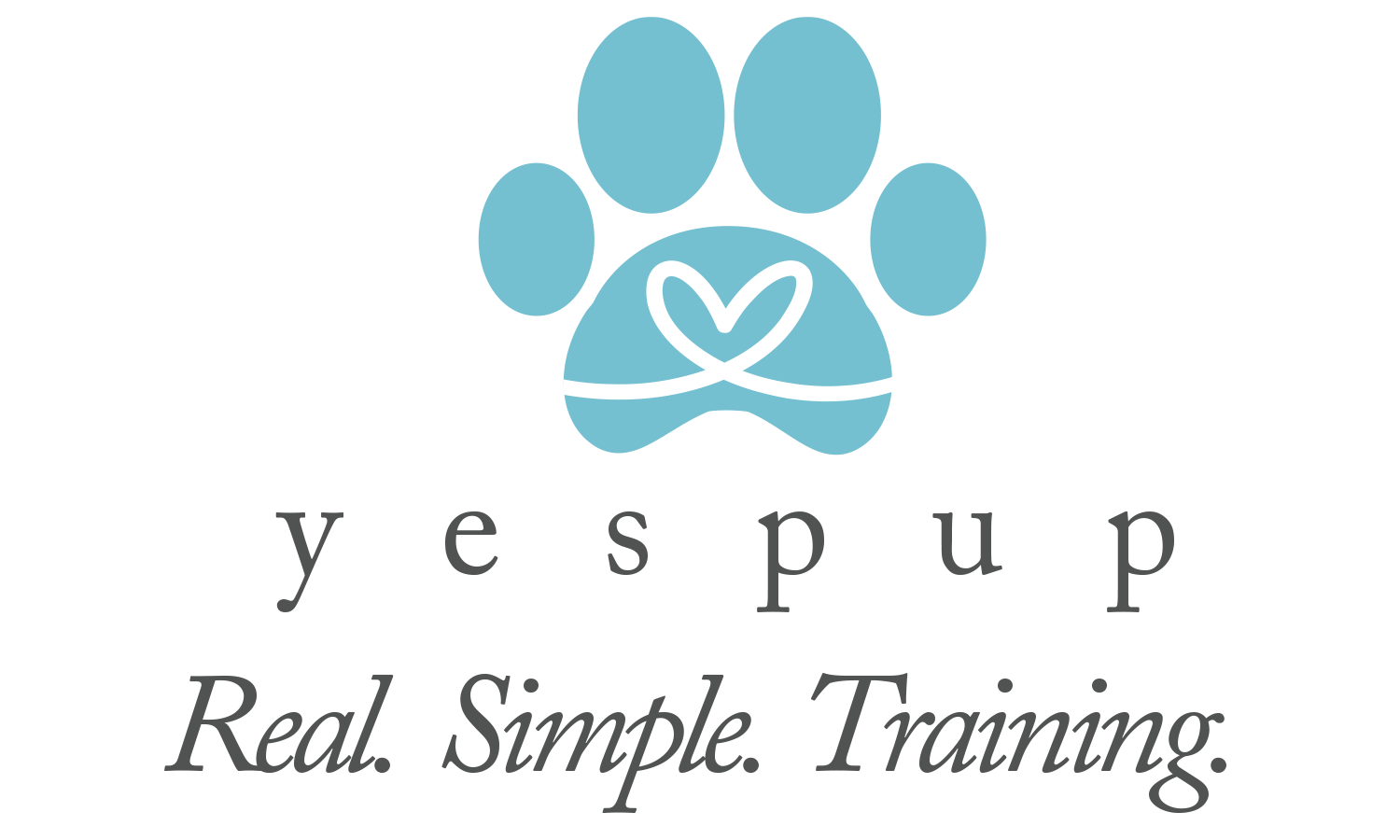
|
Home
| Contact Us
|
|

|
| Certified, Professional Dog Training and Care for Discriminating Owners |
Behavior
Photo Quiz - Answers!
What's
Going On?
Can you guess what these pictures tell about these dogs?
1.
What behavior is this Golden Retriever exhibiting? Why?
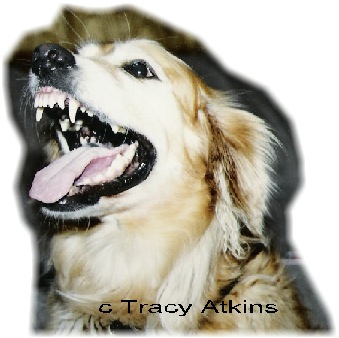
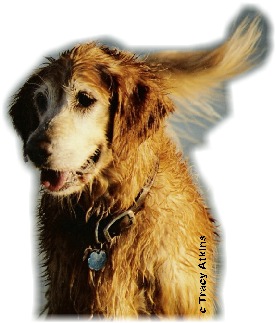
These are both photos of the same dog! In the first photo where the dog appears
to be showing aggression, she is actually performing a trained command to
"Smile" and show her teeth. This dog was trained to perform this
command to both a hand signal and a verbal command.
Even though the first photo illustrates a very seemingly aggressive dog, in reality, this dog was sweet and friendly all of her 14 years!
2. What behavior
is the black puppy laying on his back exhibiting? Why?
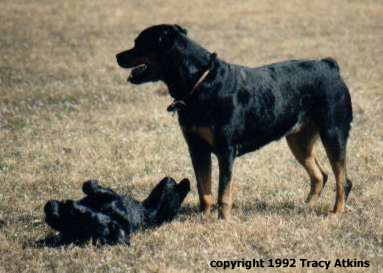
The black Labrador puppy is exhibiting a submissive posture by laying on his
back and offering his exposed belly.
The puppy lays on his back to tell the Rottweiler bitch "You're in charge. I know it. I want you to know I know it." She turns her head away from him to reduce his stress and fear while still getting her point across.
The bitch is standing near him and is NOT physically holding him down, as some humans are unfortunately instructed to do this to their puppies. It's called an "Alpha Roll". We would highly recommend against alpha rolls and instead suggest you consult other non-force methods for showing your "dominance". You might start with Doggie Brain Games.
Don't forget the puppy's submission has little to do with the fact the bigger dog is a Rottweiler. It has everything to do with the fact that this Rottweiler is an Alpha Dog to the puppy.
3. Why is
the metal bowl turned upside down inside of the larger, tan food bowl?
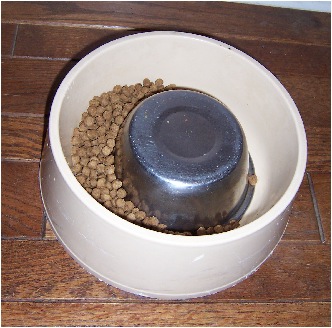
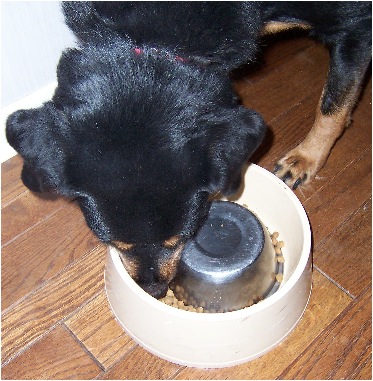
A small bowl was inverted inside the larger bowl and food was then placed
around the outside of the metal bowl to help this dog slow down eating and
prevent her from inhaling food and choking.
This technique may also be modified. Instead of using two bowls, a tennis ball may be placed in a bowl and then dog food poured in. The ball will help to slow the dog down because he will have to knock the ball around the inside of the bowl to get the kibble.
4. Who is
the more dominant dog, the Rottweiler or the Golden Retriever?
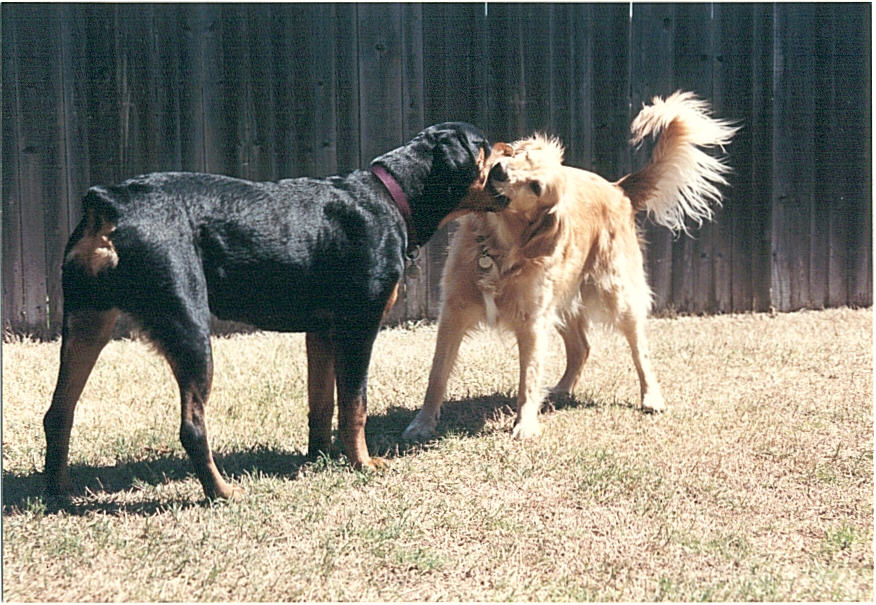
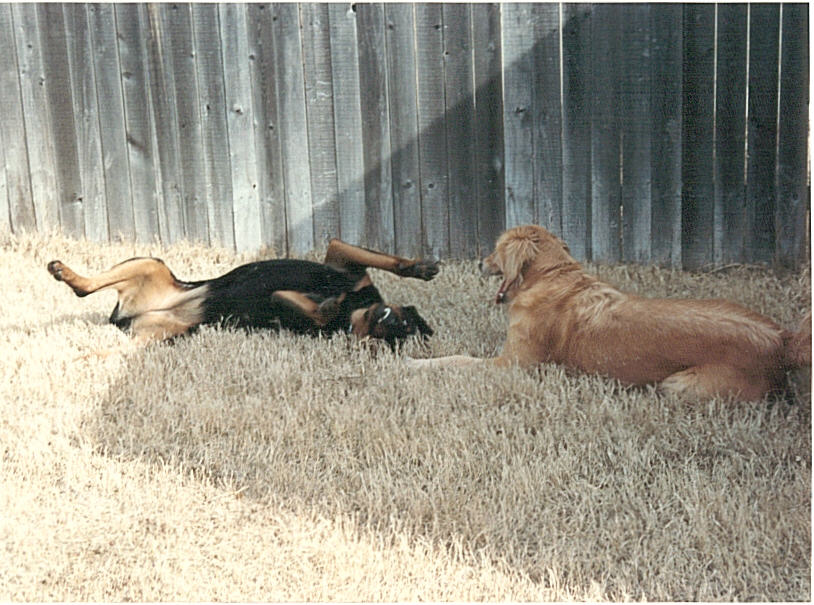
One way to determine the more dominant dog, in fact usually the easiest way
in a photo, is to examine the tail set of each dog. Stub tail dogs like Rottweilers,
Australian Shepherds may prove more challenging than long tail dogs like Golden
Retrievers, but your goal is to look at the base of the tail, by the dogs
rump.
A very high tail set (tail arched and stretched long against the dogs back) usually indicates a more dominant dog. This can be confusing if evaluating a dog like a Chinese Pug or Akita, however, it is possible! A very submissive dog will usually carry his tail tightly against his buttocks and under his belly. It's important to note, just because you see your dog one time with dominant or submissive tail sets, this does NOT indicate a totally dominant or submissive dog! It ONLY tells you where the dog is at that moment!
In the above photo on the left it appears that both dogs have a similar tail set (the height/direction at the base of the tail.) The long tail of the Golden Retriever makes her appear more dominant. However, if the Rottweiler had a tail, her tail would be about the same height/direction as the Golden's. It seems from this photo, neither dog is more or less dominant. They are caught in an equal moment of play, where neither dog wants the play to stop, so they compromise on a type of equality.
In the photo to the right, you will see that the same Rottweiler from photo's #2 and #4 is OFFERING submission to the Golden Retriever. In this photo, the Golden Retriever is clearly dominant. The Rottweiler is begging the Golden to play!
Note: These are the same dogs as pictured in questions #1 and #2.
5. Who do
you think is the Alpha Dog of this pack? Why?
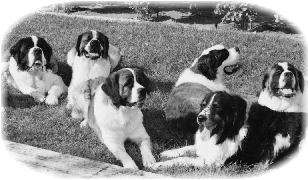
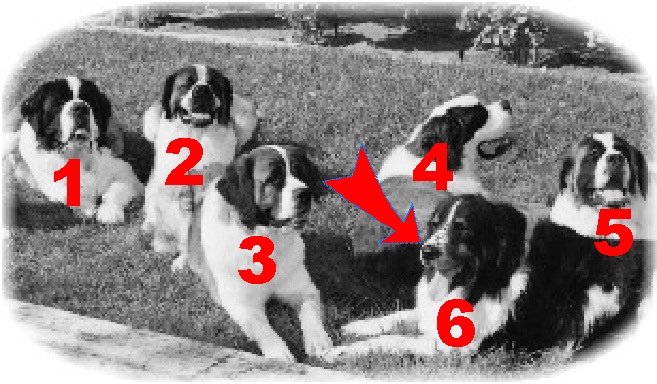
These are NOT known dogs, so in truth your answer is as good as ours!
We think the Alpha (or dominant) dog of this group is #6. When evaluating dominant dogs in the group, one need to look at each dog as an individual, then the group as a whole.
Normally, the truly dominant dog is set slightly off from the rest. He or she is usually shows few or no signs of stress (heavy panting, looking or moving away from others, whale-eye where the white of eye shows, ears pinned back, tail tucked). The Alpha dog may be male or female, but is usually the most calm, focused and physically relaxed dog of the group.
In this photo look how dog #1 is laying close to dog #2. As close as #1 is, he is leaning away from dog #2. This leads us to believe dog #1 is NOT the Alpha.
Dog #2 is laying in the prone position, looking at the person giving the command. His (her?) eyes are squinting, signaling slight stress. This leads us to believe dog #2 is NOT the Alpha.
Dog #3 is laying down with his (again, her?) body language is clearly respectful as he lays away from #6. Note how he is careful to place his left toe near, but not on, dog #6. Dog #3 is NOT the Alpha.
Dog #4 is laying with his back towards dogs #1, 2, 3 and 6 and he (she?) is avoiding eye contact with dog #5. He could be the Alpha, but isn't because he is laying too "inside" of the group, rather than on the fringe like most true Alpha's. Also, his ears appear too far back on his face and too close to his head, unlike dog #3's ears.
Dog #5 is on the outside of the pack, but he (could be she) is laying into the group. He could be the Alpha, but not for dog #6. Also his ears are back against his head, just enough to show respect. But for who? Could it be #6?
We think dog #6 is the Alpha because he (she?) appears calm in his facial expression. He is laying into the group, but with a casualness of his body. Because his muzzle appears to be greying (even though this is black and white), he appears to be older than the rest of the dogs. Age is a huge factor in determining Alpha status. Dog #6 is calm, confident and the only one not "needing" to look at either the photographer or the person directing the dogs to stay.
What did you guess?
You might be right too! Share with us your thoughts! E-mail the Complete
Canine Training Head Dog Trainer with your thoughts!